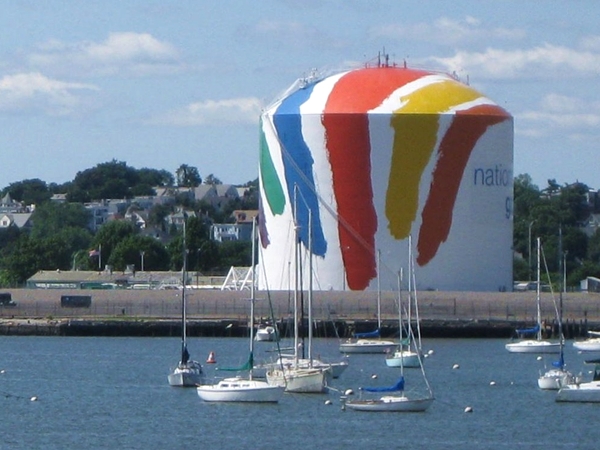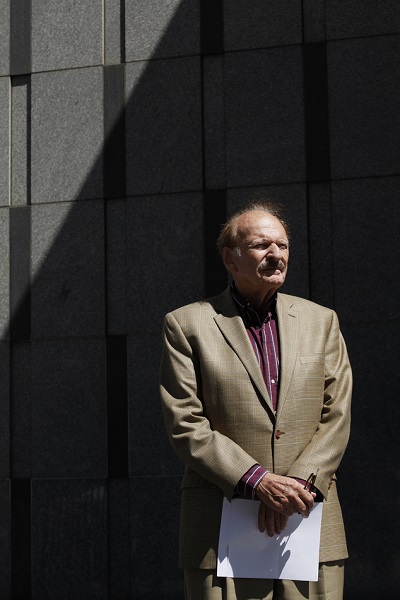Law & Politics
Photographers Sue Feds Over ‘Unconstitutional’ Surveillance Program
Since when is photographing public art a "suspicious activity"?

Photo: Courtesy Elizabeth Thomsen/Flickr.
Since when is photographing public art a "suspicious activity"?

Eileen Kinsella

For James Prigoff, it was just another day pursuing his avid interest in graffiti and street art by photographing a public mural. So how did he become a target of a federal surveillance program tracking would-be terrorists?
That question is answered in a complaint filed by Prigoff and four other men who are suing the US Department of Justice over a widespread domestic surveillance program that they allege “targets constitutionally protected conduct and encourages racial and religious profiling.” Their complaint was filed July 10 in U.S. District Court in the San Francisco–Oakland division in California. The plaintiffs include Prigoff and another photographer, one white man who is a devout Muslim, and two men of Middle Eastern and South Asian descent as described in their lawsuit. They engaged in “innocuous, lawful, and in some cases First Amendment protected activity,” the complaint states. However, due to government-issued standards that oversee the reporting of information about people supposedly involved in terrorism, all were reported as having engaged in “suspicious activities” and reports about them were entered into counter-terrorism databases. They were later subjected to “unwelcome and unwarranted law enforcement scrutiny and interrogation,” the complaint states.
Two of the men were photographing sites of “aesthetic interest,” one was likely viewing a website about video games in his home, one was buying computers at Best Buy, and another was standing outside a restroom at a train station while waiting for his mother.
Of particular interest is the case of James Prigoff, 86, who is described as “an internationally renowned photographer.” The focus of his work is public art, such as murals and graffiti art. Prigoff, who has published several books containing his photography, was in Boston in spring 2004 when he sought to photograph what is known as the Rainbow Swash, an artwork painted on a natural gas storage tank that is surrounded by a chain link fence.

Photographer James Prigoff outside the San Francisco Federal Building.
Photo: AP Photo/Alex Washburn.
According to the claim, Prigoff drove a rental car to a public area outside the fence and set up to take photographs, but was approached by private security guards who came from within the fenced-in area and advised him he was not allowed to photograph since the area was private property. Prigoff pointed out to the guards that he was not actually on private property but departed when the guards still insisted he could not photograph there. He drove to a second location where he was again followed, and then to a third location where he was not followed and was able to photograph the tank. The complaint says he later found photographs online, taken from vantage points closer than the locations he attempted to shoot from.
Prigoff Receives a Suspicious Activity Report
Despite having never supplied his identity to the two guards, the claim states, several months after retuning to his home in Sacramento, California, Prigoff found a business card from Agent A. Ayaz of the Joint Terrorism Task Force, a partnership between the FBI and other law enforcement agencies, affixed to his door with a handwritten note asking him to contact the agent. When Prigoff called Ayaz, the FBI agent asked him if he had been to Boston, and Prigoff recounted what had occurred with his attempts to photograph the Rainbow Swash. “On information and belief, security guards at the site of the Rainbow Swash had submitted a SAR [a Suspicious Activity Report] regarding Prigoff that included his rental car information, after which authorities traced him from Boston, Massachusetts, to his home in Sacramento, California.” Law enforcement agents also questioned at least one of Prigoff’s neighbors about him.
According to the complaint, through the National Suspicious Activity Reporting Initiative (NSI) the federal government encourages state and local law enforcement agencies to collect and report information that has a potential link to terrorism in the form of so-called Suspicious Activity Reports (SARs). These are collected and maintained in various counter-terrorism databases and disseminated to law enforcement agencies across the county. An individual who is reported in an SAR is flagged and automatically falls under law enforcement scrutiny, which may include intrusive questioning by local or federal law enforcement agents.
Taking photographs of infrastructure falls under one or more of the behavioral categories identified as “suspicious.” Prigoff continues to be an active photographer and often takes pictures of architectural structures and post offices, among other sites. Because taking photographs of infrastructure falls under one or more of the suspect categories, he fears that he is likely to be the subject of another SAR in the future and that his efforts to photograph will be similarly hindered.
Another Photographer Put on a Watch List
Another plaintiff who is also a photographer is Aaron Conklin, a resident of Vallejo, California, an amateur photographer who posts his work online. Because of his efforts to photograph several refineries “at night for aesthetic reasons, to capture the refinery illuminated against the dark night sky,” he was stopped by two security guards who contacted the Contra Costa sheriff’s department. They searched his car and told him he would have to be placed on an “NSA watch list.” The complaint states that “upon information and belief the Contra Costa deputy sheriffs are trained in…standards for SAR reporting.” As a result they “detained and searched Mr. Conklin for doing nothing more than attempting to photograph a site of aesthetic interest from a public location, told Mr. Conklin that he had to be placed on a watchlist, and reported Mr. Conklin in a SAR.”
Like Prigoff, Conklin fears that future attempts to photograph locations will subject him to further such scrutiny.
The claim is seeking a declaratory judgement that the Justice Department’s standard for SAR reporting is invalid and issue a permanent injunction requiring the department and Eric Holder to rescind the standards and “cease and desist from training participants” in the program, award plaintiff their legal costs, and “award such further and additional relief as is just and proper.”